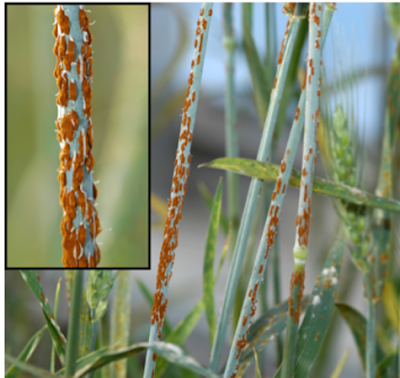Wheat Stem Rust is a major disease of wheat crops and spread by UG99 fungus. Reddish-brown flakes on plant stalks are produced by Ug99 fungus. Fungus UG99 effects wheat crops and is spreading rapidly around the world so scientists fear that it will destroy nearly all wheat crops of the world. A large number of people are dependent on wheat for nourishment so the scientists are worried about this disease. UG99 fungus is carried by wind from one place to another. For the safety of the world's wheat crop, four new mutations of Ug99, existing sources of genetic resistance have been developed.

Stem rust is a calamitous disease of wheat, caused by Ug99 fungus, member of Puccinia graminis family. Its spores affect the wheat leaf first then enter the soft tissue of the plant and seize its metabolism, siphoning off nutrients that would or else make plump the grains. When crimson pustules will be seen on the plant’s stems and leaves, then humans can know the presence of pathogen in plant. When these pustules grow, they explode and millions of spores come out to search of new hosts. Then affected plant and its grain dry up and die and turn into useless pebbles.
Stem rust is a pestilence or the polio of cultivation and almost half a century ago, it was controlled as a part of the famous Green Revolution. Scientists supervised the breed of wheat with the genes that are able to keep away the attacks of Puccinia graminis, the formal name of the fungus after years of trial and error. But now the attack of Ug99 fungus shows that success did not end. Certainly, 90 percent wheat of the world has little or no defense against the Ug99 race of P.
The food storage could become average from the Red Sea to the Mongolian steppe soon if nothing is done to sluggish the pathogen, and these crops provide a third of calories as Ug99 destroys them. The problem of mass starvation once again will be faced by the world’s biggest wheat consumers, China and India. Scientists from around the world are trying to stop this pathogen. For that, as quickly as possible they are finding a way to reach deep in the genome of wheat and make genetic barriers that cannot be defeated by Ug99.
The Borlaug Global Rust Initiative organized a global wheat event in St. Petersburg, Russia, where foremost wheat experts from Africa, Australia, Asia, Europe and the Americas took part. As per them, in comparison to the original Ug99, an even bigger risk to global wheat production may be created by the evolving pathogen. Scientist said at a global wheat rust conference in Minneapolis that super varieties of wheat that will defend against variants of the Ug99 strain of stem rust, are nearly to be produced.

Stem rust is a calamitous disease of wheat, caused by Ug99 fungus, member of Puccinia graminis family. Its spores affect the wheat leaf first then enter the soft tissue of the plant and seize its metabolism, siphoning off nutrients that would or else make plump the grains. When crimson pustules will be seen on the plant’s stems and leaves, then humans can know the presence of pathogen in plant. When these pustules grow, they explode and millions of spores come out to search of new hosts. Then affected plant and its grain dry up and die and turn into useless pebbles.
Stem rust is a pestilence or the polio of cultivation and almost half a century ago, it was controlled as a part of the famous Green Revolution. Scientists supervised the breed of wheat with the genes that are able to keep away the attacks of Puccinia graminis, the formal name of the fungus after years of trial and error. But now the attack of Ug99 fungus shows that success did not end. Certainly, 90 percent wheat of the world has little or no defense against the Ug99 race of P.
The food storage could become average from the Red Sea to the Mongolian steppe soon if nothing is done to sluggish the pathogen, and these crops provide a third of calories as Ug99 destroys them. The problem of mass starvation once again will be faced by the world’s biggest wheat consumers, China and India. Scientists from around the world are trying to stop this pathogen. For that, as quickly as possible they are finding a way to reach deep in the genome of wheat and make genetic barriers that cannot be defeated by Ug99.
The Borlaug Global Rust Initiative organized a global wheat event in St. Petersburg, Russia, where foremost wheat experts from Africa, Australia, Asia, Europe and the Americas took part. As per them, in comparison to the original Ug99, an even bigger risk to global wheat production may be created by the evolving pathogen. Scientist said at a global wheat rust conference in Minneapolis that super varieties of wheat that will defend against variants of the Ug99 strain of stem rust, are nearly to be produced.








0 comments:
Post a Comment